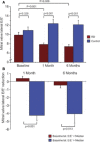Beyond blood pressure: percutaneous renal denervation for the management of sympathetic hyperactivity and associated disease states
- PMID: 25801757
- PMCID: PMC4392429
- DOI: 10.1161/JAHA.114.001415
Beyond blood pressure: percutaneous renal denervation for the management of sympathetic hyperactivity and associated disease states
Keywords: atrial fibrillation; clinical trials; heart failure; metabolic syndrome; renal denervation; ventricular tachycardia.
Figures




Similar articles
-
Renal denervation: expanding the indication.EuroIntervention. 2013 May;9 Suppl R:R101-4. doi: 10.4244/EIJV9SRA17. EuroIntervention. 2013. PMID: 23732139 No abstract available.
-
Potential new indications and future studies.EuroIntervention. 2013 May;9 Suppl R:R155-60. doi: 10.4244/EIJV9SRA26. EuroIntervention. 2013. PMID: 23732149 Review.
-
Chronic kidney disease: role of sympathetic nervous system activation and potential benefits of renal denervation.EuroIntervention. 2013 May;9 Suppl R:R127-35. doi: 10.4244/EIJV9SRA22. EuroIntervention. 2013. PMID: 23732145 Review.
-
Obstructive sleep apnoea, resistant hypertension and renal denervation.EuroIntervention. 2013 May;9 Suppl R:R105-9. doi: 10.4244/EIJV9SRA18. EuroIntervention. 2013. PMID: 23732140 Review.
-
Potential role of renal sympathetic denervation for the treatment of cardiac arrhythmias.EuroIntervention. 2013 May;9 Suppl R:R110-6. doi: 10.4244/EIJV9SRA19. EuroIntervention. 2013. PMID: 23732141 Review.
Cited by
-
Raising the Bar in Renal Sympathetic Denervation Research and Reporting.J Clin Hypertens (Greenwich). 2016 Feb;18(2):89-94. doi: 10.1111/jch.12666. Epub 2015 Sep 15. J Clin Hypertens (Greenwich). 2016. PMID: 26370742 Free PMC article. No abstract available.
-
Improvement of Myocardial Function Following Catheter-Based Renal Denervation in Heart Failure.JACC Basic Transl Sci. 2017 Jun 7;2(3):270-281. doi: 10.1016/j.jacbts.2017.03.009. eCollection 2017 Jun. JACC Basic Transl Sci. 2017. PMID: 30062148 Free PMC article.
-
Extra-cardiac targets in the management of cardiometabolic disease: Device-based therapies.ESC Heart Fail. 2021 Aug;8(4):3327-3338. doi: 10.1002/ehf2.13361. Epub 2021 May 18. ESC Heart Fail. 2021. PMID: 34002946 Free PMC article. Review.
References
-
- Davis MI, Filion KB, Zhang D, Eisenberg MJ, Afilalo J, Schiffrin EL, Joyal D. Effectiveness of renal denervation therapy for resistant hypertension: a systematic review and meta‐analysis. J Am Coll Cardiol. 2013;62:231–241. - PubMed
-
- Kandzari DE, Bhatt DL, Sobotka PA, O'Neill WW, Esler M, Flack JM, Katzen BT, Leon MB, Massaro JM, Negoita M, Oparil S, Rocha‐Singh K, Straley C, Townsend RR, Bakris GL. Catheter‐based renal denervation for resistant hypertension: rationale and design of the SYMPLICITY HTN‐3 trial. Clin Cardiol. 2012;35:528–535. - PMC - PubMed
-
- Bhatt DL, Kandzari DE, O'Neill WW, D'Agostino R, Flack JM, Katzen BT, Leon MB, Liu M, Mauri L, Negoita M, Cohen SA, Oparil S, Rocha‐Singh K, Townsend RR, Bakris GL. A controlled trial of renal denervation for resistant hypertension. N Engl J Med. 2014;370:1393–1401. - PubMed
-
- SYMPLICITY registry data spur further debate on role of renal denervation [Internet]; 2014. Available at: http://www.medscape.com/viewarticle/822839. Accessed December 20, 2014.
-
- Schmeider R. Hypertension: how should data from SYMPLICITY HTN‐3 be interpreted? Nat Rev Cardiol. 2014;11:375–376. - PubMed
Publication types
MeSH terms
LinkOut - more resources
Full Text Sources
Medical

